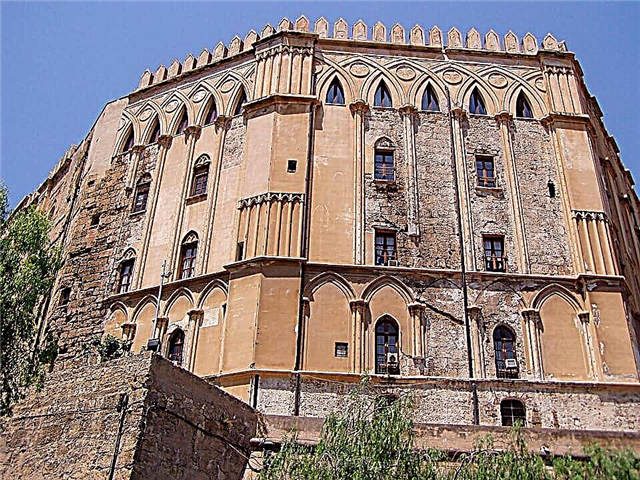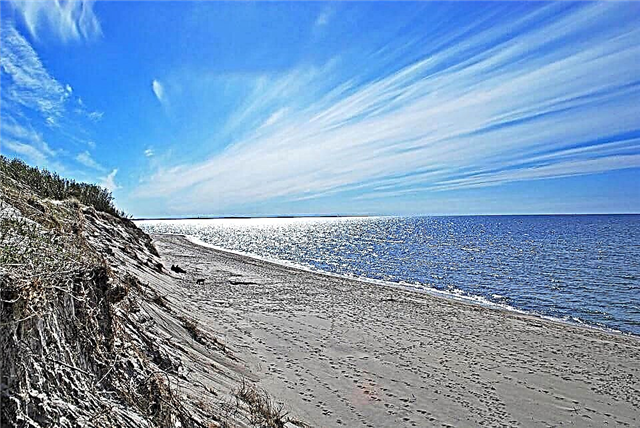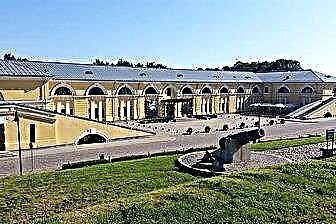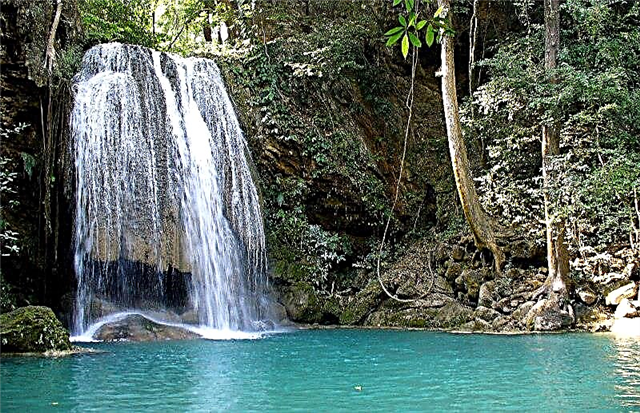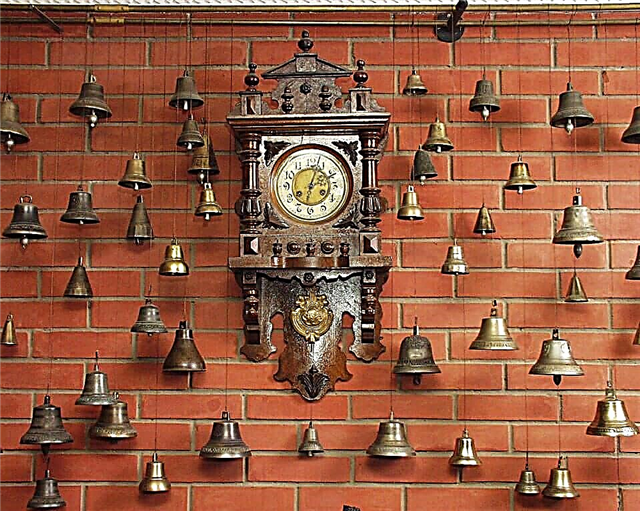The city on the Volga, founded by the Grand Duke Yaroslav the Wise, is shrouded in ancient legends and tales associated with the history of its origin. The image of a bear on the city's coat of arms is evidence that in its appearance there is a connection with this symbolic beast.
According to legend, it was in this place that Yaroslav the Wise killed a club-footed predator that caused a lot of trouble to the local residents. The city was first mentioned in the annals of 1071, and the ancient settlements of the pre-Christian era, discovered during excavations, date back to the V-III centuries BC.
By the number of priceless historical and archaeological sites located in its vicinity, this city can be called “Northern Palmyra”, the main object of the “Golden Ring” of Russia. We will tell you about the main attractions of Yaroslavl and what to see on your own.
Museum-Reserve of the Spaso-Preobrazhensky Monastery

The true pearl of the Volga city is the Museum-Reserve of the Spaso-Preobrazhensky Monastery, a majestic religious and architectural complex, partially erected in the 12th century. It is located in the center of the city, being an undoubted decoration and its most significant place.
Several objects of the complex were built later (from the 13th to the 17th century). Since 2005, all structures on the territory of the former monastery have been taken under the protection of UNESCO as an invaluable treasury of Russian history and culture.
The Spasskaya monastery (13th century), the temples of Elijah the Prophet, the Epiphany, the Transfiguration Cathedral, the churches of St. Nicholas Nadein, the Nativity of Christ, John Chrysostom are unsurpassed examples of Byzantine style architecture, captivating with their restrained beauty.
Within the walls of the monastery, since the 13th century, active educational work was carried out, a solid library was organized, and the correspondence of books. In the 16th century, the monastery courtyard was decorated with a magnificent building of the belfry, the Refectory and the Christmas Church.
A unique monument to the people's militia of 1612 was erected near the monastery - an elegant, seemingly airy small building of the chapel of the Kazan Icon of the Mother of God.
At the Holy Gates (1516) - the central entrance to the monastery, the church of the Presentation of the Most Holy Theotokos rises with a quadrangular tower. From the observation deck of the belfry, a stunning view of the ancient city opens up - a truly unforgettable sight.
Admiration is caused by the classical beauty of the Church of the Yaroslavl Miracle Workers, which contrasts in style with its architectural appearance with other temples, because it was erected already in the first half of the 19th century. This magnificent building with a colonnade is a true masterpiece of church architecture.
Transfiguration Cathedral

The main temple - the Transfiguration Cathedral (1216-1224) was built at the beginning of the 13th century, and then rebuilt after a devastating fire in the 16th century, by analogy with the cathedrals of the Moscow Kremlin.
Snow-white towers-heads with gilded domes and openwork crosses shine against the blue sky as a symbol of the holiness of the Christian faith. Zakomara arched vaults on the eastern façade, devoid of any ornamentation, reinforce the impression of holiness.
In any season, in any weather, the snow-white Cathedral of the Transfiguration of the Savior - an example of an ancient Russian temple, looks light and festive. Inside, the cathedral is painted with amazing frescoes with images of all the saints; the huge iconostasis impresses with the number of picturesque icons adorned with the richest skillful carvings.
There is no golden glitter, pretentiousness and splendor in the design, but in everything there is the highest level of art of Moscow and local masters who have created true masterpieces.
Church of Elijah the Prophet

Even the most sophisticated traveler, who has seen many architectural monuments, will freeze in admiration in front of the wonderful beauty of the Church of Elijah the Prophet in the center. It is impossible to convey in simple words the inexpressible charm of this architectural masterpiece, which has become an invaluable asset not only of the ancient city, but of the whole of Russia.
Like a fairytale tower that arose by a wave of magic, it rises over the square with white towers with green domes, attracting hundreds of tourists. The church, erected in the 17th century on the initiative of the noble merchants-brothers Skripins, is a symbol of people's love and worship of the Christian faith and its saints.
The best architects, masters from different Russian cities with a delicate artistic taste worked on the construction and decoration of a white-stone pearl, which has preserved its original appearance to this day.
After the consecration of the church, Moscow Patriarch Joseph, delighted with the beauty of the new church, as a token of gratitude handed the Skripin brothers a piece of the "robe of Christ" (it was presented to Filaret in 1625 by the ambassador of the Shah of Persia). In honor of this gift, a tent chapel of the Deposition of the Robe was added to the church, successfully complementing the captivating appearance of the church.
The interior of the temple is a real museum of icon painting and wall frescoes, striking in their diversity and high skill of execution. Many icons from the brothers' collection in silver frames, studded with precious stones and pearls, are the best examples of this genre.
Luxurious church utensils, velvet vestments of priests, magnificent chandeliers and chandeliers are real treasures.
Volzhskaya embankment

An indispensable attribute of all coastal cities - the embankment, called the Volga, is also in Yaroslavl. Its history began in the 18th century, when all monasteries were instructed to collect stone to strengthen the city's coastline. For 70 years it was possible to make only a small segment, and only in the 30s of the 19th century. large-scale works were carried out to equip the embankment along the city.
Now it is a walking place pleasing with its landscape and architectural beauty, which the city can deservedly be proud of. A luxurious linden alley is lined with patterned tiles, an exquisite cast-iron lattice separates the green coast from pedestrians.
A tall graceful rotunda with 6 columns, from which you can admire the irresistible view of Mother Volga, adorns the fence. The embankment area is crowned with a magnificent fountain, bright lawns and green lawns. Tourists and city dwellers love to visit here.
Governor's Garden

This shady, charming corner of the past is an open-air museum. The Governor's Garden (1821-1825) was established as a place for the reception of royalty in addition to the Governor's House, which is now the Art Museum.
Finding yourself behind the white cast-iron fence of the garden inside, you find yourself from modern times to the 19th century, the flavor of which is felt in the Governor's House, in numerous white sculptural statues, in the silence of the alleys.
Through the openwork of branches one can see the Church of Elijah the Prophet, complementing the nostalgic notes of staying in an infinitely lovely island of beauty and peace. Exuberant colors of flower beds against the background of green lawns, sparkling streams of a fountain framed by flower beds, art exhibitions of the Governor's House - everything here delights and leaves deep impressions.
Connoisseurs of painting will be delighted with the masterpieces of Konstantin Korovin, painted in Paris. Fans of avant-garde art will see the works of contemporary artists.
Dolphinarium

The Dolphinarium, opened in 2009, confirms that the Dolphinarium is possible not only in southern cities, but also in northern ones.
In fact, this is a huge entertainment complex, consisting of a swimming pool, a health center, a hotel, playgrounds, playgrounds, cafes and bars. Black Sea dolphins and belugas feel great in the top-quality pool, not to mention the fur seals.
Animals willingly perform a variety of tricks, make contact with people. Dolphinarium employees prepare interesting theatrical performances, where their pets show wonderful abilities, delighting the audience. The entertainment program includes joint swimming with sea animals, riding on dolphins.
In the exotic insectarium there is a kaleidoscope of live tropical butterflies, amazing in their size and colors. A rehabilitation center with dolphin therapy is becoming very popular here, which has a beneficial effect on the health of adults and children.
Zoo

The 1000th anniversary of the celebration of Yaroslavl was marked by the opening of a magnificent zoo (120 hectares), in which the main goal was to ensure a comfortable stay of animals and birds on its territory. Judging by the feedback from visitors, this condition is met, because the inhabitants of the zoo do not huddle in cramped cages, but live and breed in spacious enclosures in an environment close to natural.
The animals look vigorous and well-groomed and are well fed. Children love the areas of the zoo where they can interact closely with the peaceful species of animals and birds. The territory of the zoological park is very picturesque. There are charming ponds and lakes for waterfowl; flamingos live on special cozy islands.
There are rocky slides for ungulates; many trees, shrubs, flowers - this is what a modern zoo looks like. The educational and demonstration center "Kovcheg" has been opened here, where students deepen their knowledge of biology and zoology. There are cafes and kiosks.
Kazan women's monastery

This is one of the active women's monasteries in Russia, founded in the 17th century - its spiritual and architectural treasury, steeped in legends. According to one of them, the Icon of the Kazan Mother of God helped the residents in the fight against the Polish-Lithuanian invaders, and a temple was erected in honor of the miraculous icon. Over the years, the Kazan monastic monastery was formed around it, the beginning of which was laid by 72 nuns from the Rozhdestvensky Monastery, fleeing from the invaders.
Many times the women's monastery in the 20th century underwent destruction and desolation, but in the 21st it was restored to its former form. Now the Kazan Monastery is taken under the protection of UNESCO as the greatest architectural and religious monument.
A copy of the 19th century from the miraculous Kazan icon is the main holy relic of the monastery along with the relics of the holy Metropolitan Agafangel. The healing power of the miraculous image of the Mother of God attracts thousands of those eager to get rid of diseases, troubles and grief.
White-stone temples (there are 4 of them) delight everyone with their renovated domes, magnificent architecture and priceless holy relics.
Einstein's Museum of Entertaining Sciences

An extraordinary museum, where each visitor is not a passive contemplator of the exhibits, but an active participant in entertaining processes and scientific experiments, opened in 2013.
In the Einstein Museum of Entertaining Sciences, anyone can feel like a super-strong hero, a great scientist or a participant in an extreme experiment. The purpose of the institution is to awaken in children an interest in learning, in scientific research, a desire to penetrate the secrets of science.
Everyone who comes here can independently create an optical illusion, the effect of magnetism, lift a lot of weight with one little finger, and make cold water boil. Here you will learn the principles of friction, impulses, lightning, levers, arches; get acquainted with the pendulums of famous scientists, Tesla's ball.
There are 100 amazing exhibits in 8 halls of the museum, but their number continues to grow, scientific and entertainment programs are expanding taking into account the new achievements of science.
Above the entrance to the museum building there is a famous portrait of Einstein, a bright inscription with the name and banners with the scientist's statements. Students and schoolchildren are happy to come here.
Museum "Music and Time"

This museum is the first private museum in Russia, opened by an unusually interesting person, John G. Mostoslavsky, a magician and passionate collector. From childhood, he began collecting coins, bells, and various souvenirs.
The hobby grew into a serious professional occupation, which made it possible to create a huge collection of musical instruments, porcelain, samovars, irons, porcelain and other items. In 1993, in a small merchant's mansion, the Museum "Music and Time" was opened, containing 3 expositions.
One of them (located in the basement) presents a variety of irons, illustrating the evolution of this household appliance from an ancient ruble to a modern iron with an electric cord. The main exposition is a hall filled with antique clocks with musical strikes, music boxes of various stripes and sizes.
Gramophones and gramophones, harmonium, xylophone were lined up in a row. The collection of bells on which you can play the melody of "Moscow Nights" is unusually interesting. This hall is a real music salon.
In the next room, everyone is welcomed by a collection of samovars, from the smallest (100 grams) to the huge (10 liters) of various configurations and designs. The museum presents cast iron products, striking in their diversity and graceful beauty: caskets, vases, figurines, ashtrays, etc.
A small collection of porcelain figurines from different parts of the world is very impressive - real artistic masterpieces. A wonderful museum gives the most pleasant experience to people of all ages.
Park on Damansky Island

The favorite place of rest of the townspeople and guests is the park on the island. Damansky is a local tourist Mecca that attracts people with its natural and man-made beauty and many entertainments. Now it is difficult to imagine that several decades ago there were private gardens on the island, where the owners sailed on boats.
The rave reviews of tourists testify to the extraordinary attractiveness of the wonderful recreation and entertainment park. The island got its name in honor of the events that took place in 1969 on the Russian-Chinese border.
A beautiful, seemingly airy bridge with high graceful supports, with an openwork metal fence, on which the newlyweds hang "locks of fidelity", leads to the island. Bright spots of flower lawns and flower beds, lush greenery of trees, lawns make the territory of the park unusually picturesque. The variety of dizzying rides makes children and adults squeal with delight.
Fans of extreme sports choose the "Free Fall Tower", which is rapidly rushing down, or "Roller coaster" with trailers racing at a crazy speed. There is a place for children of all ages to have fun: carousels of various types, animation shows, roller and bicycle tracks, segway rides.
In winter, skiing, snowmobiling, sledging and horse-drawn carriages along the park alleys are popular here.
Millennium Park

A modern park, opened for the 1000th anniversary of the city in 2010 on the site of the former hippodrome on the banks of the river. Kotorosli. Famous natives of the city, V. Tereshkova, B. Gryzlov, A. Pakhmutova and others, took part in laying the park along with ordinary citizens.
Millennium Park is part of the grandiose City Park project - a leisure and entertainment center with excellent infrastructure, including a hotel, a magnificent concert hall, a business center and a sports complex. Fountains, lawns and original sculptures adorn the territory of the young park, where there are still no shady alleys (trees are just gaining strength), but this does not interfere with the good rest of the townspeople.
The range of entertainment here is rich and varied: wonderful playgrounds for kids; bike and roller skate rental, skateboard - for teenagers; dancing accompanied by a brass band for adults.
A symbolic figure of a bear (a gift from Z. Tsereteli), with a nose rubbed to shine by visitors, was installed in the park.There are boat stations and a yacht club on the bank of Kotorosl, where you can take a boat or sail on a yacht along the picturesque surroundings.
There is a good private beach here, which turns into an ice rink in winter. On the territory there are a cafe and a restaurant, a summer cinema. Nearby (across the road) are the unique churches of St. Nicholas Mokroi, Tikhvin and Planetarium. Leisure in the Millennium Park is not inferior in terms of the level of infrastructure to the famous parks of Europe.
Stone at the site of the founding of the city

One of the main symbols is a stone block, installed on the supposed site of the city's foundation in 1010 by Prince Yaroslav the Wise. This miraculous monument is popular among tourists strolling along the Volga embankment.
According to legend, the stone is more than two million years old. It is believed that a boulder one and a half meters in size has healing power from diseases and is able to fulfill innermost dreams.
It is enough just to touch with two palms to its cool surface and mentally make a wish. It is from this stone relic that the centuries-old history of Yaroslavl begins. The stone symbolically marks the place where the Grand Duke Yaroslav the Wise hacked a bear with an ax, after which he ordered the foundation of the future city.
Bronze map of the historic city center

A bronze map of the historic city center is spread out on a marble pedestal in a cozy square on Sovetskaya Square. The sculptural composition is a model with captured areas included in the UNESCO World Heritage List.
The statue is made in the form of a scroll, the corner of which is decorated with the decree of Empress Catherine II on the approval of the town planning of Yaroslavl. On the map you can see three-dimensional models of historical architectural ensembles built at the confluence of the Volga and Kotorosl rivers. Buildings outside the UNESCO area are shown schematically.
Museum-reserve "Rostov Kremlin"

The ancient city of Rostov Veliky, famous for its unique white-stone architectural ensemble, is located 60 kilometers away. The main attraction of the city is the state museum-reserve - "Rostov Kremlin".
This popular tourist destination is steeped in the atmosphere of the millennial history of the ancient Russian kingdom. The territory and chambers of the reserve served as filming grounds for the legendary Soviet comedy film Ivan Vasilyevich Changes His Profession.
Behind the powerful fortress walls of the Rostov Kremlin there are majestic temples, belfries, chambers and outbuildings. The construction of the architectural complex began in the second half of the 17th century at the behest of Metropolitan Iona Sysoevich of Yaroslavl.
The interior of the Kremlin is filled with three zones: the bishop's court, the Metropolitan Garden and the Cathedral Square. In the center of the complex there is a pond, on the banks of which you can sit on a bench admiring the historical buildings.
Tall churches with exquisite massive domes and unique frescoes make a gracious impression on the visitors to the Kremlin. Covered arched passages against the background of melodic bell chimes will not leave anyone indifferent.
The pearl of the museum-reserve is the Assumption Cathedral, which amazes tourists with its monumental size. Its height is about 60 meters. The structure is crowned with five silvery domes. Zakomaras, arcature belt and pilasters give the temple a special expressiveness and solemnity.
Assumption Cathedral

The Assumption Cathedral rises majestically over the Volga coast. This is an outstanding monument of the traditions of ancient Russian architecture. The construction of the first religious building took place in the 13th century. Over its long history, the temple has been repeatedly destroyed by fires and looted interior decoration. In 1937, the old church suffered the worst fate - it was completely blown up by the Bolsheviks.
The solemn consecration of the revived Assumption Cathedral took place on the day of the celebration of the 1000th anniversary of the city. In 2010, the temple again became an architectural dominant at the confluence of the Volga and Kotorosl rivers.
The white-stone structure clearly symbolizes the steadfastness of the Christian faith on Russian soil. The grandiose temple impresses with its size. It rises up to 50 meters and can simultaneously accommodate about 4 thousand parishioners.
The shrine is crowned with five gilded domes mounted on drums with narrow windows. The walls of the cathedral end with a semicircle of zakomar. The facade is decorated with tiles covered with colorful ornaments. The main entrance to the temple is crowned with a mosaic icon of the Dormition of the Mother of God. Several thousand tiles were used to create the picturesque panel.
Anyone can visit the cathedral at any time. Free admission. Church services in the temple are held twice a day: at 8:00 and 17:00.
Church of John the Baptist

In one of the districts, next to the factory buildings, stands a unique monument of Russian architecture of the 17th century - the Church of John the Baptist. This is the only temple in Russia topped with fifteen green chapters of various sizes.
The image of the church can be seen on the back of the 1,000-ruble note. The cathedral, built of red brick, is abundantly decorated with intricate figured ornaments and numerous tiles.
The facade amazes the imagination with its patterns made of brick details. On three sides, the temple is framed by covered one-story galleries, the entrance to which is a high porch. The interior of the church is in no way inferior to the excellent appearance.
The painting of the interior decoration amazes with the beauty and variety of biblical subjects. The ceilings, walls and pillars are painted with picturesque frescoes. The interior has preserved iconostases decorated with fine wood carvings.
The Church of John the Baptist is open to the public every day, except Mondays and Tuesdays, from 10:00 to 17:00.
Church of the Savior on the City

Not far from the bank of the Kotorosl River in the 17th century, the old Church of the Savior on the City was erected. Throughout its history, the temple has been repeatedly rebuilt and restored. Surprisingly, the masterpiece of temple architecture withstood the years of the Civil War and religious persecution.
The place where the shrine now stands was previously the focus of the main market. Numerous shops and rows occupied a vast territory, which turned into a whole trading city. Therefore, the church received such an unusual name as Savior on the City.
The small, four-pillar temple is crowned with five green domes supported by massive and high light drums. The surfaces of the heads are covered with relief carvings. A hip-roof chapel, decorated with rows of kokoshniks, and a hipped-roof bell tower adjoin the northern facade of the church.
The interior of the chapel is made up of colorful icons and ancient frescoes depicting highly revered saints, including particles of their relics. The temple is open to parishioners and tourists every day. Services are held at 8:30 and 16:00. Free admission.
Chapel of Alexander Nevsky

The chapel of Alexander Nevsky attracts attention with its laconic forms and facade decorations. An architectural monument of Orthodox art was erected at the end of the 19th century. The reason for the construction of the shrine was the miraculous rescue of Emperor Alexander III and his family during a railway crash near Kharkov.
The appearance of the Alexander Nevsky chapel is a truly mesmerizing sight. The square structure with an attached semicircular apse is made of red brick, and numerous decorative elements are white. At the base of the structure there is an octagonal drum topped with a hipped roof with a golden dome. The surface of the tent is covered with gray ceramic tiles.
The facade of the temple is abundantly decorated with tiles, intricate figures of stone carving, cornices with ornamental stripes and kokoshniks. Window openings are framed with snow-white carved platbands.
The hipped porch, which stands on barrel-shaped columns, gives a special charm to the building. The interiors of the chapel are painted with colorful frescoes. In the prayer hall there is a wooden iconostasis covered with skillful carving.
The Alexander Nevsky Chapel is open daily from 9:00 to 17:00.
Monument to Yaroslav the Wise
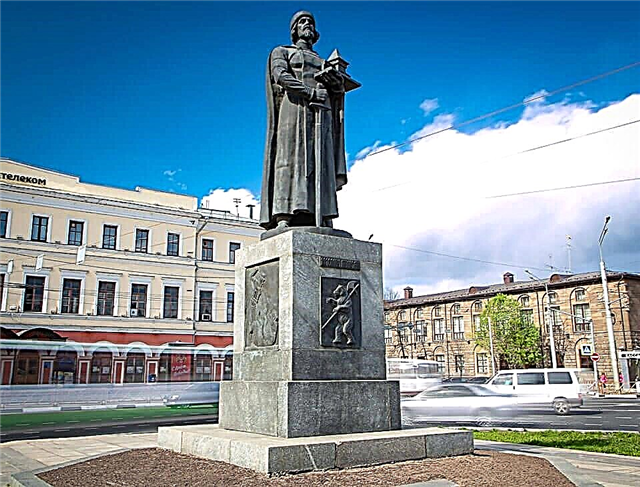
On a small island of Epiphany Square, a monument has been erected to the statesman and founder of the city - Prince Yaroslav the Wise. The opening of the monument took place in 1993. The statue of the prince meets everyone entering the city from the direction of the Moscow direction. The sculptural image of Yaroslav the Wise holds a model of the city in one hand, and a sword lowered with a blade down in the other.
The monument represents the prince as a protector and creator. The high pedestal of the monument is decorated with bas-reliefs depicting scenes from the life of Yaroslav the Wise. The monument stands inside the motor transport ring. The heavy flow of cars prevents tourists from coming closer to the monument and appreciating its artistic merit, since there are no pedestrian crossings.
Monument to Peter and Fevronia

A bronze monument to Saints Peter and Fevronia, who are the heavenly patrons of family and love, adorns Pervomaisky Boulevard. The monument was solemnly erected in 2009. Not far from the statue of the Muromsky married couple is the central Wedding Palace. After the official wedding part of the painting ceremony, the newlyweds first come to the monument to bow to the saints.
The sculptural composition consists of three-meter images, half-turned to each other. A pair of doves sits in their palms, which symbolizes peace and harmony. Noteworthy is the detailing of the bronze folds and ornaments of the figures' robes, as well as the expressions on the faces of the spouses. There is a beautiful flower bed near the monument.
Zero kilometer of the Golden Ring

In a cozy park with wrought iron benches on Voskresensky Boulevard, there is a memorial sign indicating distances and directions to the eight cities of the Golden Ring. This is Kilometer Zero, opened on the day of the celebration of the 1003rd anniversary of the birth of the city.
The monument is presented in the form of a cast-iron column mounted on a pedestal. The faceted base of the monument is decorated with bas-reliefs depicting a schematic map of the "Golden Ring", as well as the coats of arms of ancient cities.
Sculptural composition "Trinity"

On the Volga embankment in front of the majestic Assumption Cathedral there is an unusual sculptural composition dedicated to the Holy Trinity, highly revered in Russian Orthodoxy. This is the only statue in Russia that embodies in volume the famous icon of the same name by Andrei Rublev. The sculpture was installed in honor of the celebration of the 1000th anniversary of the baptism of Rus.
Interpretation of the icon-painting image caused ambiguous assessments of local residents. Bronze images of the Father, the Son and the Holy Spirit have a disproportionate and simplified appearance, which does not correspond to the traditional beliefs of believers.
After the blessing of the sculpture, which was given by Patriarch Alexy II, the discontent of the townspeople subsided. Today the monument "Trinity" occupies an honorable place in the list of attractions.
Demidov pillar

In one of the city's parks, the Demidov Pillar rises up, erected in honor of the famous Russian industrialist and scientist Pavel Grigorievich Demidov. He made a significant contribution to the development of the scientific and educational activities of the Fatherland. P.G. Demidov, using his personal savings, founded the first higher educational institution, which admitted his students in 1803.
The first opening of the monument took place in 1829. The masterpiece of monumental art was created through volunteer donations from the townspeople. During the formation of the Soviet regime, the pillar was destroyed. In 2005, the column was revived again, thanks to the preserved drawings, and took its historical place.
A slender bronze column of the Doric architectural order stands on a granite pedestal.
Its top is crowned with the figure of a gilded two-headed eagle with spread wings on the celestial sphere. The height of the building is 12 meters. A well-groomed public garden is laid out around the monument, where you can take a pleasant walk.
City History Museum

The former merchant mansion of the 19th century houses a museum of the history of the city. The exhibition occupies six halls, in which the original interiors of the century before last have been preserved.
The museum fund consists of 25 thousand unique exhibits of historical and artistic value. The expositions have collections of household items, photographs, numismatics, faleristics, models of attractions, jewelry, graphics, tools, arts and crafts, works of art by masters and other artifacts of the thousand-year history of the city.
The exhibition dedicated to the development of medicine is of the greatest interest to visitors. In this section of the museum you can see old tools, equipment, pharmaceutical devices, as well as personal belongings of doctors. Open daily, except Tuesday, from 10:00 to 18:00.
Museum of Foreign Art

Tourists can get acquainted with the masterpieces of the cultural heritage of different countries of the world in the Museum of Foreign Art. The cultural institution is housed in a classic two-story 19th century mansion on Sovetskaya Square.
The exhibition consists of works of art of the 16th-20th centuries, which previously belonged to Yaroslavl landowners and merchants. The exposition presents masterpieces of Western European and Oriental craftsmen. These are paintings, furniture sets, sculptures, graphics and household items.
Particularly attractive are colorful 18th century English prints depicting natural landscapes, scenes from everyday life and caricatures of social phenomena of that time. It is worth taking the time to inspect the sets, figurines, vases, chests, furniture sets and sculptures made by the masters of France, Italy, Germany and the Netherlands. A massive Italian table with gilded carved legs arouses undoubted interest.
Colorful stones such as marble, malachite, jasper and lapis lazuli were used in the manufacture of the countertop. Admire the intricate carving and marble inserts of the French bunk wardrobe. Showcases with clothes of Chinese aristocrats are extremely curious.
Robes, shirts and headdresses are embroidered with gold thread and decorated with intricate ornaments. It is impossible to indifferently walk past Japanese dolls, fans and exquisitely painted porcelain plates.
The Museum of Foreign Art receives visitors every day, except Mondays. Exhibition working hours: from 10:00 to 18:00 and from 12:00 to 20:00 (on Fridays).
Museum "My Favorite Bear"

Diversify the kaleidoscope of pleasant impressions from sightseeing by visiting a private museum - "My Favorite Bear". It is not surprising that such an unusual institution has been opened in the city, the symbol of which is the bear.
This fabulous place is filled with an atmosphere of kindness. A lot of toy club-footed characters from plush, sawdust, felt, wood, porcelain, straw and other all kinds of materials "live" here.
The museum's small rooms are filled with toys. Among the inhabitants of the "den" there are rare and modern exhibits of various sizes, types and ages.
The bears settled behind the glass of the shelves, on the shelves, sofas and just on the floor. The museum has a souvenir shop and a small teahouse.
Mishkin's house is open every day, except Monday, from 11:00 to 19:00.
Museum of Military Glory

A specially built exhibition complex houses the Museum of Military Glory, dedicated to the military valor and heroism of the Russian people. The exhibits reflect the exploits of the inhabitants during the bloody conflicts that have shaken the Fatherland more than once.
The collection of the fund is divided into thematic sections related to certain historical periods. These are the Mongol-Tatar invasion, the Polish-Lithuanian intervention, the Patriotic War of 1812, the First World War and the Great Patriotic War.
Various types of firearms and edged weapons, models of artillery cannons, uniforms of soldiers, items of military equipment, personal belongings of soldiers, awards of various denominations and other artifacts are exhibited here.
The most remarkable and informative exposition of the museum reflects the invaluable contribution of the Soviet Army to the victory over the German fascist invaders. In the pavilion, you can see various military weapons, anti-aircraft guns, an aerial bomb body, a field bag, military uniforms and much more.
On the territory adjacent to the complex, there is an alley of military equipment of the Soviet period. Exhibited here: a T-54 tank, an anti-aircraft missile system, an aircraft, an armored personnel carrier and artillery guns.
Znamenskaya tower

Znamenskaya Tower is a unique architectural monument and cultural heritage site, erected in the middle of the 17th century. The fortification served as the main city gate. The facade of the building was decorated with the icon of the Sign of the Mother of God, which blessed the arriving travelers. Soon a chapel was added to the building, which in 1861 became a full-fledged temple.
The tower impresses with its monumental dimensions. The thickness of the impregnable blank walls reaches six meters. The four-tiered structure has narrow loopholes and its walls are crowned with battlements. Znamenskaya tower with a church forms a single architectural ensemble. The facade of the temple attracts attention. It is decorated with carved cornices, stucco moldings, low columns, arched windows and a pediment, the top of which is completed by a gilded dome.
Art Museum

It occupies the luxurious spacious rooms of the historic mansion on the Volzhskaya embankment. The building has long been the residence of the governors.
The gallery has a very impressive collection of Russian art. The museum fund has about 70 thousand valuable exhibits. These are paintings, sculptures, icon painting, tapestries, antique furniture and masterpieces of decorative and applied art.
The most interesting is the impressive collection of paintings. The paintings amaze with their high writing technique and subjects.
Here are the paintings of eminent Russian masters, such as: I. Repin, I. Shishkin, A. Savrasov, K. Bryullov, I. Aivazovsky, V. Polenov, D. Levitsky and many other famous artists.
The art museum displays porcelain, ceramics and glass products, as well as carved furniture, unique icons, church utensils, coins and precious fabrics.


